| État du Voisionçal State of Voisionçal | |
|---|---|
| Conventional short name: | |
| Local: | Voisionçal |
| Ingallish: | Voisionçal |
| Data codes: | VS, VSO |

| |
| Languages: | |
| Official: | Phenixien |
| Others: | Sanpatrician, Afrazlala, Sterv, Yare |
| Cities: | |
| Capital: | Chèrse |
| Other: | Juichon, Côte de Déesse, Alge, Iciouis |
| Government type: | Federal Republic |
| President: | Richard Géroux |
| Population: | 7.275.000 (320 est.) |
| Established: | 9th of August, 320 |
| Currency: | Casquette |
The State of Voisionçal (Phenixien, État du Voisionçal; Afrazlala, Jimbo ya Wozontsah; Sanpatrician, Estado del Voisionçal, Sterv, Foisonsríki; Yare, Jihar Fosontsah) is a country is western Melania.
Etymology[]
The country is named after the old Brolecian state of Voisionçal or Vosionsal, of which most of its territory was formerly a part of.
Government[]
Voisionçal is a federal, presidential multi-party republic, ruled by a directly-elected president. The legislative branch is composed of a single house, the Assemblée d'État (in Ingallish, State Assembly), made of fourteen delegates from each province. The cabinet follows the Lendonsan model, in which all government ministers must be selected by the president from the 70 delegates of the Assemblée.
The current president of Voisionçal is Richard Géroux, of the Democratic Socialist Party, appointed by occupation authorities following the Portocapitalian-led intervention in Stervia in August 320.
The country is divided in five provinces, each with its own directly-elected governor and an Assemblée Provinciale (Provincial Assembly) made of 36 delegates.
History[]
(Main article: History of Voisionçal)
Although first settled by modern Homo sapiens around the 6th millenium before the Plague, urban civilization did not appear in modern Voisionçal until circa 1.500 BP, with the emergence of several independent city-states. These early polities would occasionally form large temporary alliances for trade and self-defence, such as the Djigarthan Empire (1.320 BP - 1.150 BP) around the modern city of Chèrse, or the League of Sarnithil (1.300 BP - 1.070 BP), in the south of the country. Between 1.100 BP and 970 BP, northern Voisionçal came under control of the Kingdom of Aziri, based out of present-day North Brolecia. Following the collapse of Aziri, the region experienced the mass migration of semi-nomadic Mezapatani groups from the Bajapean rainforest - which, by 770 BP, fell under the influence of the Kingdom of Sigga. Meanwhile, in the south, the independent city-states thrived longer, until falling to the expanding Zangan Empire in 760 BP.
Sigga controlled a large network of vassals, stretching from the Bajapean jungle to the Navigators Gulf. This put them at odds with the Zangan Empire, which led to the Zangan-Sigga Wars of 739 BP to 716 BP. Although Zanga emerged victorious, the immense cost in human lives contributed to the collapse of the empire beginning in the 690s. This allowed for the formation of various indigenous realms, such as the Kingdom of Skruyu and the Maritime Alliance, as well as the beginning of large-scale trade with the Nuarmian nations across the Melanian channel.
Sterv settlers first arrived in the area in 550 BP, founding several coastal villages such as Ithwillis and Aage, while putting their services as traders and navigators at the disposal of the local ruling classes. Explorers from Longerath also reached present-day Voisionçal between 450 BP and 448 BP. Between 280 BP and 270 BP, the region was conquered by the Empire of Afrazure, which held it until the first decades after the Plague, despite pressure from the Longerathian colonial powers.
Voisionçal was the main battleground of the Afrazurean counter-offensive during the Maurestani-Afrazurean war of 173 to 176. Ultimately, the Empire of Maurestania won the conflict. The northern part of Voisionçal, up to the Equator, was directly annexed to Maurestania, while the rest was ceded to a puppet Afrazurean colonial regime. Most indigenous peoples were expelled from Voisionçal during the "Trails of Blood" between 193 and 202 to make room for more "desirable" colonists from Eras and Longerath - most notably, Phenixien-speaking settlers from present-day Phenixia, as well as ethnic Maurestani and Stervs.
Starting on the 230s, the mountainous areas of southeastern Voisionçal became a hotbed for anti-colonial guerillas, mostly centered around the Melanian Liberation Army and the Terrehaute Panther Movement. Despite alternating periods of successes and defeats, the struggle continued until the late 290s, with the end of colonial rule in Afrazure in April 299 and the fall of Maurestania itself during the following month, after the Maurestani War. Voisionçal became a part of the new Federal Republic of Brolecia, which gave way to the Stervian Confederation in February 302. The oppressive regime of Stervia, meanwhile, fell in mid-320, following a military intervention led by Porto Capital. The new, independent State of Voisionçal was established on the 9th of August 320.
Geography[]
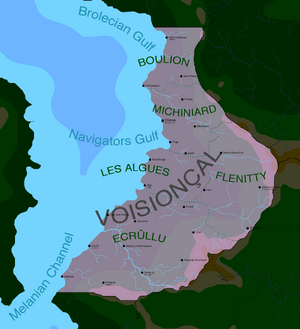
Map of the State of Voisionçal
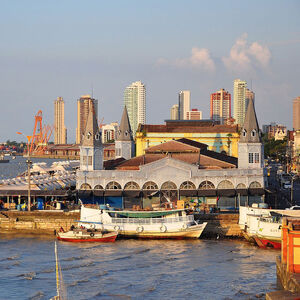
The old ferry station in Chèrse, capital of Voisionçal
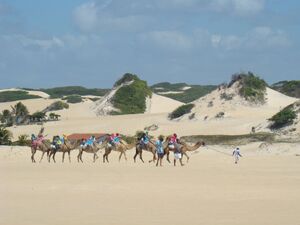
A camel train crossing the coastal dunes of Les Algues
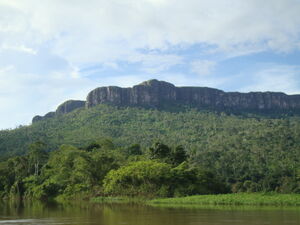
The Terrehaute plateau in southeastern Ecrûllu, near the border with Katikati
The territory of Voisionçal comprises parts of the former Brolecian states of Voisionçal, Skruyu and Flenyitty. The country is located in western Melania, bordering Porto Capital, North Brolecia, Katikati and Kiso. Administratively, it is composed of five provinces: Boulion, Ecrûllu, Flenitty, Les Algues and Michiniard. The Melanian Channel, only 105 kilometers wide at its narrowest point, separates the country from Caledon, in the continent of Nuarmia.
Voisionçal is marked by an extensive coastal plain, which gradually gives way to complex mountain systems to the south and east of the territory. The country is separated from North Brolecia by the low-lying Trenchinne hills and the more massive Apulanta highlands - both ranges are collective known, locally, as the Voisionçal cordillera. Further to the south, the Terrehaute plateau, an important mesa system, marks the border with Katikati, with two main passes - the valley of the Pollaigne river and the Kodago Passage - allowing easy transit into the neighbouring nation. On the far south, the Tsatali mountains, originating in Allacoa, reach into the province of Ecruûllu, serving as the border between Voisionçal and Kiso.
The northern part of Voisionçal is covered by the thick Bajapean rainforest which, as we go south, gives way to broad grasslands, while the far-south is dominated by the high-altitude Kiso rainforest. On the eastern reaches of the country, the highlands are covered by sparse, high-altitude forests and savannas. The coastal strip, meanwhile, is marked by mangroves and salt marshes, with complex dune systems around the Navigators Gulf.
The northern and southern parts of the country are marked by a pronounced humid tropical climate (Af), with heavy rainfall throughout the year and an annual median temperature of 28,7°C. The central regions, meanwhile, offer a slightly milder tropical savanna climate (Aw), with a more pronounced dry season and average temperatures of 26,9°C. The easternmost parts of the country, around the Pollaigne valley, have a hot semi-arid climate (BSh), much like nearby Katikati, with infrequent rains, hot summers, when temperatures normally rise above 32°C, and cooler winters, when temperatures may fall as low as 10°C.
Demographics[]
Unlike most other countries in former Stervia, the majority of the population of Voisionçal belongs to non-indigenous ethnic groups, as most of the native peoples were expelled during the "Trails of Blood" between 193 and 202. While the country has 7.275.000 inhabitants, over 77% of these are grouped under the "White Brolecian" ethnicity - that is, descendants of Longerathian colonisers who first arrived in the region after 140 BP and, later, in larger numbers, after the Trails of Blood. Other non-native groups, namely the Maurestani and the Stervs, make up, respectively, 8% and 5% of the total population. The remaining 10% of the population belongs to indigenous Melanian ethnic groups, such as Yarene (5%), Zangans (2%), Mezapatani (2%) and Afrazah (less than 1%).
Phenixien is the most widely spoken language of Voisionçal, spoken by 82% of the country's population. Other languages include Sanpatrician (5%), Sterv (5%), Afrazlala (4%), Yare (2%), Zangan (1%) and Mezapatani (less than 1%).
Voisionçal is an overwhelming Cruisan country, with over 89% of the total population adhering to this religion. A majority (79%) of all Cruisans in the nation adhere local churches or unorganised dioceses formerly aligned to the Imperial Maurestani Church. Other Cruisan denominations present in Voisionçal include the Church of Altland (18%), the Papaist Episcopal Church of Listonia (8%) and the Ordlandic Church (2%).
Mounists comprise 7% of the total population, with the majority (97%) adhering to the Maurestani sect and 3% to the indigenous Nijiakale tradition. Other 2% are Mezapatists. Around 1% adhere to other native Melania religions, while the remaining 11% are self-declared atheists or irreligious.
Economy[]
Along with North Brolecia, Voisioçal is the most well-developed of the post-Stervian successor states, holding an important and diverse economical base. Despite the disastrous policies of the Stervian regime, Voisionçal did not experience a massive and active campaign of disinvestment and deindustrialization, as happened in Katikati or Zanga. Although some heavier and more strategic industries were indeed dismantled and transported to Sterv-dominated areas in present-day North Brolecia during the 310s, most lighter industries remained in place - in fact, cities such as Iciouis, Cerne-Içi and Alge, home of a large ethnic Sterv minority, did receive significant government investment during the Stervian era.
Industry comprises about 53% of Voisionçal's gross domestic product (GDP), including key sectors such as heavy manufacturing, metallurgy and mining. Lighter industries, however, make up a majority of the country's economic base, including food processing, textiles, electronics, pulp and paper and consumer goods.
Voisionlaç has important reserves of strategic resources, such as nickel, bauxite, manganese, gold, niobium and copper, mostly concentrated on the country's eastern highlands, while small deposits of petroleum and natural gas can be found in the central areas of the province of Ecrûllu.
Services amount to 27% of Voisionçal's GDP, with key sectors being retail, transportation, information technology, asset management and professional services. Agriculture, centered on large, privately-owned farms and ranches, is responsible for the remaining 20% of the country's gross domestic product. Important crops include coffee, tobacco, cotton, maize and tropical fruits. Livestock is also an important component of Voisionçal's economy, as the country is the largest producer of beef, pork and poultry in former Stervia.
The existence of an informal sector - that is, both unregistered sales, imports and exports, as well as illegal activities - is not as big as a problem in Voisionçal as it is in other neighbouring countries, such as North Brolecia, Katikati and Zanga. Still, several strips of territory in the far-south of the country still fall under the influence of large drug cartels.
The currency of Voisionçal is the Casquette.
Symbols[]
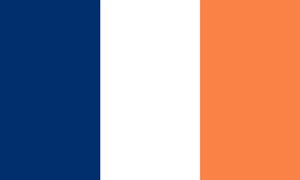
National flag of the State of Voisionçal
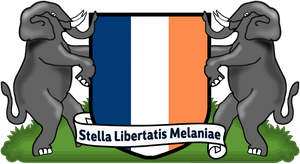
Coat of arms of Voisionçal
The flag of Voisionçal is a vertical tricolour of dark blue, white and orange - essentially, the same flag used by the Brolecian state of Voisionçal between 299 and 302. The national coat of arms is composed by the flag in a shield form, supported by two elephants, including a scroll with the Liliani motto Stella Libertatis Melaniae (in Ingallish, star of Melanian freedom).
Subnational flags[]
Military[]
The State of Voisionçal inherited roughly one quarter of the equipment and personnel of the former Stervian armed forces. With close to 25 thousand active personnel, the Forces Armées du Voisionçal are divided in three branches: the Land Guard of Voisionçal (Garde de Terre du Voisionçal), the Air Guard of Voisionçal (Garde de l'Air du Voisionçal]] and the Naval Guard of Voisionçal (Garde Navale du Voisionçal).




